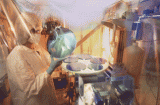One of the primary ways people find structure and coherence in the world is to identify fundamental characteristics common within and between apparently different classes - plants, humans, atoms, stars, etc. In the case of diverse biological life we know that RNA and/or DNA are common to them all. Thus, a deeper understanding of the architecture and interactions of RNA and DNA will lead to a greater understanding of the commonalities underlying all biological life.
Approximately 1,700 scientists visit SSRL annually to conduct experiments in broad disciplines including life sciences, materials, environmental science, and accelerator physics. Science highlights featured here and in our monthly newsletter, Headlines, increase the visibility of user science as well as the important contribution of SSRL in facilitating basic and applied scientific research. Many of these scientific highlights have been included in reports to funding agencies and have been picked up by other media. Users are strongly encouraged to contact us when exciting results are about to be published. We can work with users and the SLAC Office of Communication to develop the story and to communicate user research findings to a much broader audience. Visit SSRL Publications for a list of the hundreds of SSRL-related scientific papers published annually. Contact us to add your most recent publications to this collection.
Determining how RNA (ribonucleic acid) folds, or "ravels", may offer a key to un-raveling how and why anomalies occur in the human genome. RNA is now known to play a pivotal role in gene silencing, gene shuffling, protein regulation and disease. However in contrast to proteins, very little is known about how RNA takes its three-dimensional shape and under certain circumstances works as an enzyme. Getting a good look at RNA in the process of folding from its initial 1-D "ribbon" state, into a 3-D "knot" (the form in which RNA is biologically functional) would be very valuable information
Much of our manufactured environment - many metals, plastics, glasses, ceramics, fiberglass and papers - consists of extrusion-molded products. To minimize waste, extrusion-molding plants must balance quality of product, speed of process and cost of production (primarily electricity) for each particular material. They need to know how fast each material can be processed at what energy cost while maintaining the quality of the finished bulk material. Fundamental changes in the macromolecular arrangement of materials occur at critical deformation rates.
Electrocatalysis is the science of modifying the overall rates of electrochemical reactions so that selectivity, yield and efficiency are maximized. Studies in electrocatalysis have resulted in tools such as highly selective multicomponent gas mixture sensors and better electrocatalysts for the fuel cells. Markovic and Lucas have been very active in studying the mechanisms by which these catalysts operate and developing in-situ surface x-ray scattering (SXS) techniques for their studies.
Increasing the speed and complexity of semiconductor integrated circuits requires advanced processes that put extreme constraints on the level of metal contamination allowed on the surfaces of silicon wafers. Such contamination degrades for example the performance of the ultra thin SiO2 gate dielectrics (< 4nm) that form the heart of the individual transistors. Ultimately, reliability and yield are reduced to levels that must be improved before new processes can be put into production. Much of this metal contamination occurs during the wet chemical etching and rinsing steps required for the manufacture of integrated circuits and industry is actively developing new processes that have already brought the metal contamination to levels beyond the detection capabilities of conventional analytical techniques.
Attempting to determine and describe the atomic arrangements in an amorphous material is a daunting prospect. A considerable advance has been made in the anomalous X-ray scattering approach to determining these arrangements in materials containing two atomic species.
Many condensed matter systems can be described as large collections of microscopic entities, each of which can be in one of two possible states. For example, in many anisotropic magnets spins can point in one of two directions along a unique crystalline axis. In a liquid-gas phase transition, molecules will be in either the gas or liquid phase. When the microscopic entities interact, they may exhibit collective long-range order. A collection of two-state particles with near-neigh bor interactions is known as an Ising system. This simple system is very important because the behavior that an Ising system displays as it undergoes a transition to long-range order has universal features that are independent of the details of the two-state particles or their interaction.
The Research group of Douglas Rees at the California Institute of Technology collected X-ray crystallographic data to a resolution of 1.16 Å at SSRL Beam Line 9-2 using the new Quantum-315 CCD detector from crystals of Nitrogenase MoFe-Protein, an extremely efficient enzyme found in bacteria that catalyzes the production of ammonia from dinitrogen. Bacteria produce about half of the world’s bio-nitrogen available for agriculture, the rest comes from nitrogenous fertilizer produced chemically at extreme temperature and pressure, consuming about 1% of the world's total annual energy supply.
Transport proteins, embedded in lipid membranes, facilitate the import of nutrients into cells or the release of toxic products into the surrounding medium. The largest and arguably the most important family of membrane transport proteins are the ABC transporters. They are ubiquitous in biology and power the translocation of substrates across the membrane, often against a concentration gradient, by hydrolyzing ATP (Higgins, 1992).
In the well-known Greek legend the touch of King Midas would convert anything to metallic gold. Recently, a team working at SSRL lead by Professor Jorge Gardea-Torresdey from the University of Texas at El Paso have shown that ordinary alfalfa plants can accumulate very small particles (nanoparticles) of metallic gold (1). The best-known materials that contain nanoparticles of metallic gold are gold colloids. These lack the familiar metallic luster, but show bright colors which range from red, violet or blue, depending upon the size of the nanoparticles (2,3).














